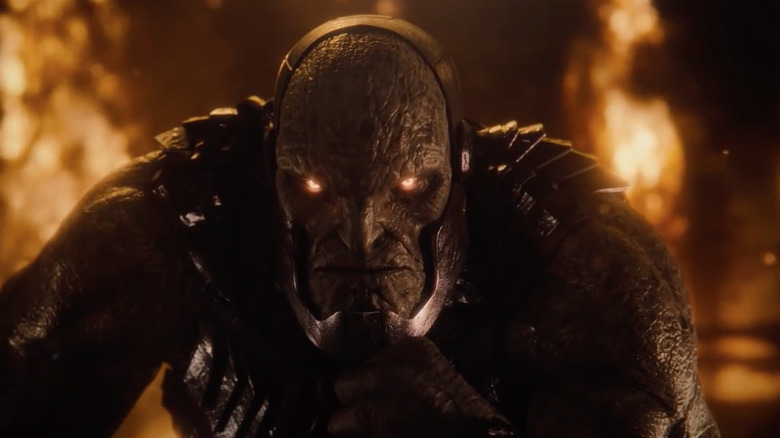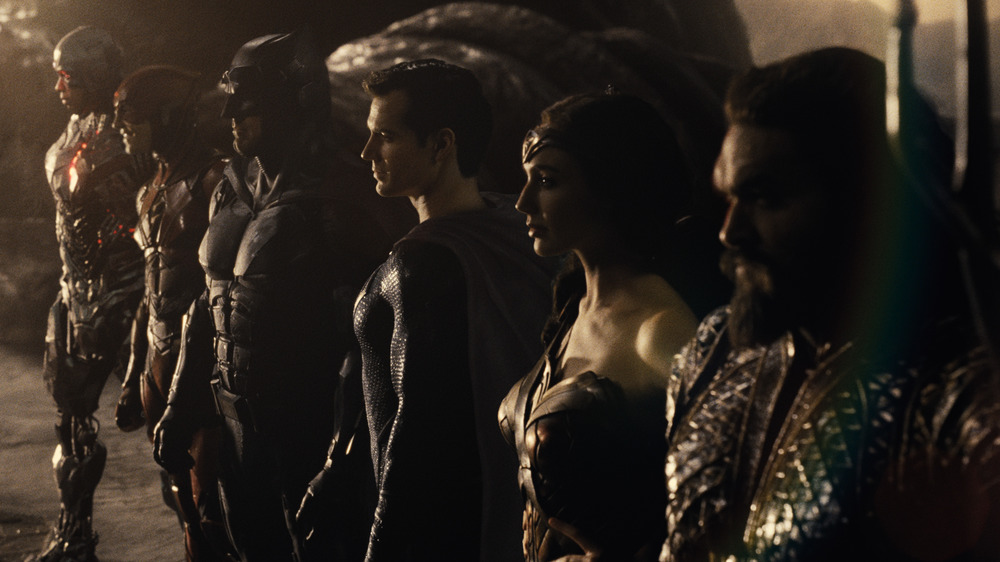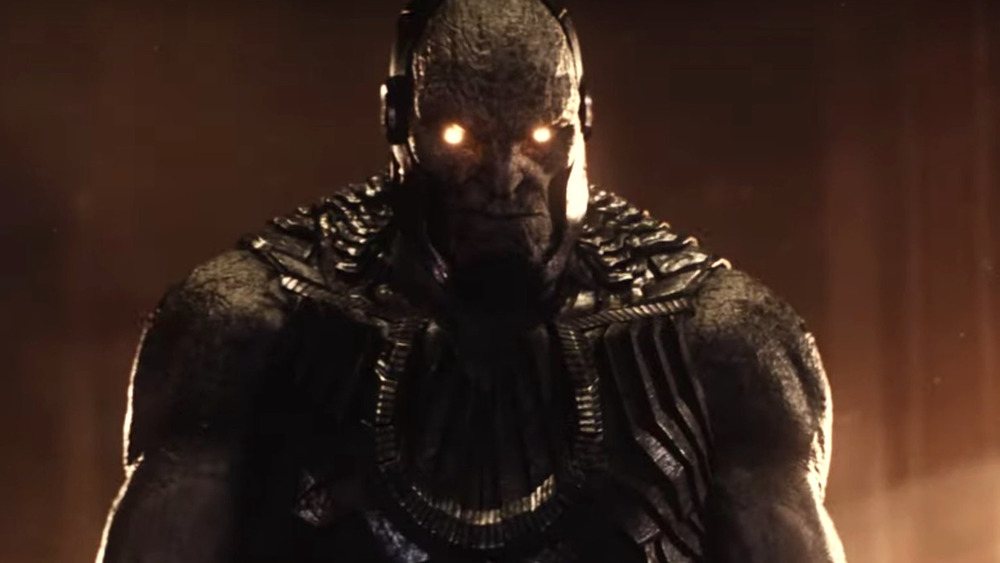Zack Snyder's Justice League Review: It's Bigger, But Is It Better?
Clocking in at a whopping 243 minutes — that's two Empire Strikes Backs! — here comes Zack Snyder's Justice League. The movie is now twice as long, and quite honestly, twice as good. But is it anywhere close to even the worst Avengers movie for pure entertainment? Not even in the same universe.
For those of you who haven't spent the last three years tweeting #ReleaseTheSnyderCut, some background info might be required. In the early half of the last decade, 300 filmmaker Zack Snyder was handed the keys to the DC Universe and got to work making a so-called "Snyderverse" of films that included Man of Steel, Batman v Superman: Dawn of Justice, and via proxy (he served as producer) Suicide Squad, Aquaman, and the Wonder Woman movies. These films referenced and impacted each other like Marvel's MCU, and it was all designed to culminate in a superhero hootenanny, much like 2012's Avengers had done for the competition.
After spending considerable time on Justice League, Snyder was forced to leave following a personal tragedy (ZSJL is dedicated to his daughter, Autumn). The director of Avengers, Joss Whedon, was brought in to pick up the pieces — and the result was 2017's tattered tentpole Justice League. DC fans were convinced that Snyder's original vision had been for something far greater, so they launched a groundbreaking effort (blessed by stars including Ben Affleck and Gal Gadot) that convinced Warner Bros. to finance 2500 VFX shots, a new soundtrack, and re-shoots.
And when you watch Zack Snyder's Justice League, you'll be surprised at how "new" it all feels. There is so much never-before-seen footage, in fact, that it's almost a different movie entirely. Snyder insists to this day that he has never seen the 2017 Justice League, which results in a fascinating cinematic experiment far more ambitious than your typical director's cut. Future generations of film students could derive valuable insight by comparing both movies for a unique glimpse at what's it's like to see a puzzle assembled — and then assembled again in a different order by someone who has approximately twice as many extra pieces.
From here on out, it's impossible to break down ZSJL without going into what's new, what's old, what's better or worse. So even though it feels silly to provide a spoiler alert for a film from 2017, you've been warned.
The tonal dichotomy between the Snyder and Whedon films is struck right out of the gate: Justice League began with a cute video of podcasting kids interviewing Superman after he saves the day; Zack Snyder's Justice League has Superman dying in slo-mo and screaming "noooo!" while Wonder Woman and Batman watch helplessly. His dying scream echoes throughout all the homelands of the various heroes, alerting the world that its protector has perished.
With that, the differences fall into three categories: the good, the bad, and the head-scratchers.
Heroes (Re)Assembled
The biggest improvement of ZSJL is the luxury of time. Many scenes get to breathe, so there is extra shading on the portraits of these iconic characters, resulting in higher stakes when they all come together. This includes Batman's recruitment of Aquaman (now, local villagers serenade Arthur Curry as he swims away), Wonder Woman's thwarting of the terrorists (it's now implied that she killed the ringleader), and the evil Steppenwolf's battle with the Amazons (there is substantially more horse-throwing). The Flash has a great new intro that puts him on a job interview, falling for a girl (Kiersey Clemons) in peril; Cyborg's massively expanded storyline has him playing football, assisting an innocent, and grappling with re-envisioned loss.
Other plot points now make more sense. In Justice League, Steppenwolf selects a somewhat random village to build his empire; in ZSJL, there's discussion of the Russian village's toxicity to humans (which also removes the lazily drawn civilian locals in Justice League). In ZSJL, we get more clarity on how Wonder Woman becomes aware of the Amazonian alert to Steppenwolf's invasion — and see Diana investigating the matter in a Tomb Raider-ish sequence. Wonder Woman's recruitment of Cyborg, previously brokered with words appearing on a computer screen, is vastly improved.
When the Justice League members lay out their theory for Superman's rebirth using the metaphor of smoke particles rebuilding the house they destroyed, it makes sense of the plan — and the Mother Boxes as well. ZSJL also presents an interesting new theory: Steppenwolf and Darkseid stayed away from Earth until now because they were afraid of Superman.
Smaller matters have also been redone, like an ID sketch of the STAR Labs infiltrator that now looks less like a Parademon and more like Batman, making it more plausible when some assume the Dark Knight has turned bad. Or Barry Allen's "Lois Lane is the key" line from Batman v Superman, which is now finally paid off.
Then there are the bad decisions. Many of these are tonal, reflecting Snyder's preference of melancholy over mirth. Nearly an hour into ZSJL, there's still no introduction of the Flash, the main source of release in Justice League. That self-seriousness can be a bit suffocating, and it doesn't help that Cyborg (who Snyder considers the heart of the Snyderverse) isn't seen for more than a glimpse until minute 77. Making matters bleaker is Snyder's removal of gags like Barry Allen drawing glasses on someone, or a line about Batman being in big trouble if Superman comes back from the dead.
It can be reasonably assumed that such moments were Whedon's work, and Snyder gave the Heisman to anything that wasn't his own doing. If so, that feels like the cinematic equivalent of cutting off one's nose to spite the face — if Snyder has never seen Justice League, does he even know such scenes exist? Does he realize they could have helped lighten the mood? Clearly, Whedon is not in Hollywood's good graces right now, but in a 243-minute movie of unlimited real estate, it seems myopic to ignore moments that could help overcome the film's greatest flaw.
Which brings us to the head-scratchers, and in ZSJL there are more than a few. Despite the opportunity for a mulligan, when Wonder Woman lassos a terrorist and asks "Who are you?" he still doesn't answer until she explains to him (and dumbs down for the audience) that the lasso compels him to speak truth. Despite all the new VFX work, Steppenwolf remains a distracting, computer-generated eyesore.
Before, when Steppenwolf caught a missile from Batman's Knightcrawler vehicle, he ruminated on the primitive weaponry of humans; now, he silently tosses it aside. When Queen Hippolyta (Connie Nielsen) engineered a Mother Box relay race, it was imperative that the box be evacuated quickly; now, she grabs it but stops for random swordplay, running up a wall, a hallway battle and checking in on a wounded soldier. In Justice League, Batman advised a nervous Flash to focus on saving just one person; loyal butler Alfred (Jeremy Irons) had a cool moment bringing in "the big gun" to calm Superman — now both scenes are missing. All these moves add nothing; if anything, they only subtract.
But now there are Nazis. And Superman in a black suit. And out of nowhere, Martian Manhunter. But none of that adds anything substantial either.
Come to the Darkseid
This brings us to the last nitpick, and it is of significant substance. Love or hate Justice League, Steppenwolf was a toothless villain. That is amplified further by ZSJL, which tells us more about his downfall, his pledge to conquer 50,000 worlds, and his connection to Darkseid — essentially, his nephew and boss.
Darkseid's presence in the film (appropriately for our times, felt via interplanetary Zoom calls) undermines Steppenwolf, who now resembles evil middle management. Batman and his fellow Earthbound super-Karens want to take up their grievance with Steppenwolf's boss, but instead they're fighting the outer space equivalent of Dwight Schrute. Keeping with this metaphor, ZSJL's DeSaad is Toby Flenderson, the nosy guy who keeps getting in the way and no one is really sure what his job even is.
It's been said that DC is about gods and Marvel is about humans becoming gods. Batman, Superman, Wonder Woman, Aquaman, the Flash — these icons are comic book royalty, worthy of the most epic of storylines. Learning so much more about their backstories, feeling the renewed presence of Snyderverse supporting stars (Willem Dafoe, Kevin Costner, Robin Wright, even Russell Crowe), and cool new shots like Flash singlehandedly stopping debris from crushing civilians by catching each piece as they fall — heck, even the new chapter titles — finally makes this Justice League feel epic.
But right at the very end comes ZSJL's only newly filmed scene, an eye-popper involving Batman, the Joker (played by Jared Leto), and other post-apocalyptic adventurers. As the Snyderverse signs off for what might be the last time, it serves as a final reminder of its shortcomings. So much potential, so much proficiency — all mired in a dour, exhausting, unappealingly dark night.


